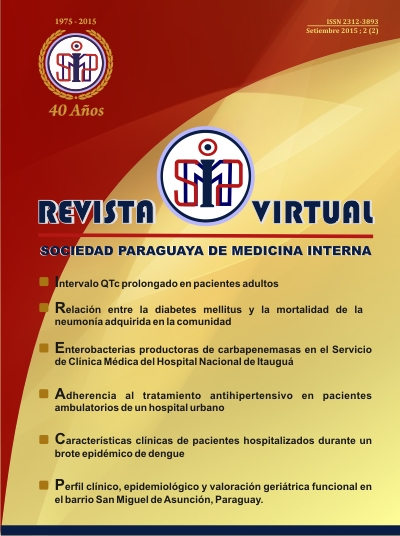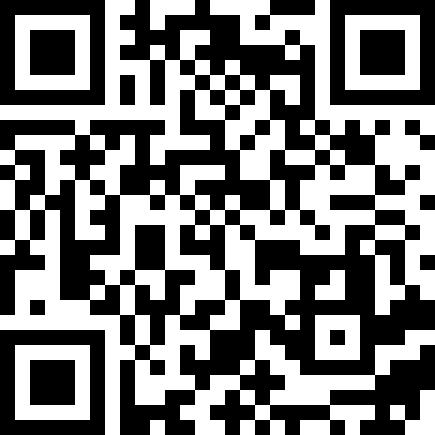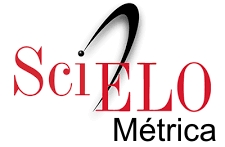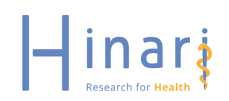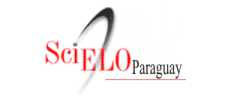Características clínicas de pacientes hospitalizados durante un brote epidémico de dengue
Resumen
Introducción: el dengue es una enfermedad dinámica, multisistémica, de etiología viral, con cuatro serotipos, endémica en el Paraguay. Se presenta con espectro clínico variable. Entre los meses de febrero y abril de 2015 se registró un brote epidémico en la ciudad de Coronel Oviedo (Paraguay), por lo cual se incrementó el número de consultas y casos de pacientes que necesitaron ser hospitalizados.
Objetivos: determinar las características clínicas de los pacientes durante el brote epidémico de 2015.
Metodología: estudio observacional, transversal, retrospectivo, descriptivo, no probabilístico, con componente analítico. Fueron revisadas historias clínicas de mujeres y varones mayores de 18 años internados en el área destinada a los pacientes con dengue en el Hospital Regional de Coronel Oviedo entre los meses de febrero y abril de 2015.
Resultados: la edad media de los enfermos fue 42,1 ±18,6 años, 70,43% fueron mujeres. El 100% de los pacientes presentaban cuadro clínico compatible con dengue; en 77,05% de los casos el antígeno NS1 dio positivo y en 59,02% hubo nexo epidemiológico. El 77,05% presentaron signos de alarma, siendo la trombocitopenia el más frecuente (65,57%). Durante la fase crítica de la enfermedad se internaron el 80,33% de los pacientes. La hipertensión arterial fue la comorbilidad asociada más frecuente (39,34%). Se halló una correlación negativa débil entre el recuento plaquetario y los valores de enzimas hepáticas. La media de días de hospitalización fue 4,49±1,93 días.
Conclusiones: la edad media fue 42,13 ±18,66 años, la mayoría fueron mujeres. El 100% de los pacientes presentaban cuadro clínico compatible con dengue; en la mayoría de los casos el Ag NS1 dio positivo y un alto porcentaje se confirmó por nexo epidemiológico. El 77,05% presentaron signos de alarma, siendo la trombocitopenia el más frecuente, durante la fase crítica de la enfermedad se internaron el 80,33% de los pacientes.
Citas
Gubler DJ. The global emergence/resurgence of arboviral diseases as public health problems. Arch Med Res. 2002 Jul-Aug; 33(4): 330-42.
Holmes EC, Twiddy SS. The origin, emergence and evolutionary genetics of dengue virus. Infect Genet Evol. 2003 May; 3(1): 19-28.
WHO. Comprehensive guidelines for prevention and control of dengue and dengue hemorrhagic fever /Internet/. Indian: WHO; 2011. (SEARO Technical Publication Series No. 60). /citado 9 oct 2014/. Disponible en: http://apps.searo.who.int/pds_docs/B4751.pdf?ua=1
Gibbons RV, Vaughn DW. Dengue: An escalating problem. BMJ. 2002 Jun 29; 324(7353): 1563-6.
Chao DY, Liu YJ, Shen WF, Tu WC, Galula JU, Wu HC. Comparison of E and NS1 antigens capture ELISA to detect dengue viral antigens from mosquitoes. J Vector Borne Dis. 2015 Apr-Jun; 52(2): 134-41.
Shepard DS, Coudeville L, Halasa YA, Zambrano B, Dayan GH. Economic impact of dengue illness in the Americas. Am J Trop Med Hyg. 2011 Feb; 84(2): 200-7.
WHO. Working to overcome the global impact of neglected tropical diseases: First WHO report on neglected tropical diseases. /Internet/. Geneva: WHO; 2010. /citado 9 oct 2014/. Disponible en: http://whqlibdoc.who.int/publications/2010/9789241564090_eng.pdf
San Martín JL, Brathwaite O, Zambrano B, Solórzano JO, Bouckenooghe A, Dayan GH, Guzmán MG. The epidemiology of dengue in the Americas over the last three decades: a worrisome reality. Am J Trop Med Hyg. 2010 Jan; 82(1): 128-35.
Shepard DS, Coudeville L, Halasa YA, Zambrano B, Dayan GH. Economic impact of dengue illness in the Americas. Am J Trop Med Hyg. 2011 Feb; 84(2): 200-7
Ferreira Germano LC. Global dengue epidemiology trends. Rev Inst Med Trop. S. Paulo [Internet]. 2012 Oct [cited 2015 March 10] ; 54(Suppl 18): 5-6. Available from: http://www.scielo.br/scielo.php?script=sci_arttext&pid=S0036-46652012000700003&lng=en.http://dx.doi.org/10.1590/S003646652012000700003.
WHO. Dengue and severe dengue [ Internet]. Geneva: WHO; 2012 [cited 2013 March 4]. Available from: http://www.who.int/mediacentre/factsheets/fs117/en/index.html
Pan American Health Organization. Number of reported cases of dengue and dengue severe (DS) in the Americas, by country: Figures for 2011 (to week noted by each country) /Internet/. Epidemiological Week /EW49. [up dated 9 December 2011; cited 2011 Dec 18]. Available from: http://new.paho.org/hq/dmdocuments/2011/dengue_cases_2011_January_21_EW_3.pdf
WHO. Global strategy for dengue prevention and control, 2012–2020 /Internet/. Geneva: WHO Press; 2012. /cited 2013 nov 10/. Available from: http://www.who.int/immunization/sage/meetings/2013/april/5_Dengue_SAGE_Apr2013_Global_Strategy.pdf
Messina JP, Brady OJ, Scott TW, Zou C, Pigott DM, Duda KA, et al. Global spread of dengue virus types: mapping the 70 year history. Trends Microbiol. 2014 Mar; 22(3): 138-46.
Tapia-Conyer R, Betancourt-Cravioto M, Méndez-Galván J. Dengue: an escalating public health problem in Latin America. Paediatr Int Child Health. 2012 May; 32 Suppl 1:14-7.
Giménez V, Picagua E, Carpinelli M, Rovira C, Ferreira L. Hallazgos laboratoriales y referencia sintomatológica en población pediátrica durante la epidemia de dengue del año 2007. Pediatr. (Asunción) 2011; 38(1): 12-6.
Ministerio de Salud Pública y Bienestar Social. Dirección General de Vigilancia Sanitaria. Dengue. Boletín epidemiológico /Internet/. 2014 /cited 2014 dec 17/;(51):3-6. Disponible en: http://www.vigisalud.gov.py/images/documentos/boletines/2014.12.29%20boletin%20epidemiologico.pdf
Chen LH, Wilson ME. The role of the traveler in emerging infections and magnitude of travel. Med Clin North Am. 2008 Nov; 92(6): 1409-32, xi.
Gubler DJ. Dengue, urbanization and globalization: The unholy trinity of the 21(st) century. Trop Med Health. 2011 Dec; 39(4 Suppl): 3-11.
Endy TP, Anderson KB, Nisalak A, Yoon IK, Green S, Rothman AL, et al. Determinants of inapparent and symptomatic dengue infection in a prospective study of primary school children in Kamphaeng Phet, Thailand. PLoS Negl Trop Dis. 2011 Mar 1; 5(3): e975.
WHO. Dengue: Guidelines for diagnosis, treatment, prevention and control. /Internet/. Geneva: WHO; 2009. /citado 12 ago 2013/. Disponible en: http://www.who.int/tdr/publications/documents/dengue-diagnosis.pdf
Kalayanarooj S, Vaughn DW, Nimmannitya S, Green S, Suntayakorn S, Kunentrasai N, et al. Early clinical and laboratory indicators of acute dengue illness. J Infect Dis. 1997 Aug; 176(2): 313-21.
Alexander N, Balmaseda A, Coelho IC, Dimaano E, Hien TT, Hung NT, et al. Multicentre prospective study on dengue classification in four South-east Asian and three Latin American countries. Trop Med Int Health. 2011 Aug; 16(8): 936-48.
Horstick O, Jaenisch T, Martinez E, Kroeger A, See LL, Farrar J, Ranzinger SR. Comparing the usefulness of the 1997 and 2009 WHO dengue case classification: A systematic literature review. Am J Trop Med Hyg. 2014 Sep; 91(3): 621-34.
Lanciotti RS, Calisher CH, Gubler DJ, Chang GJ, Vorndam AV. Rapid detection and typing of dengue viruses from clinical samples by using reverse transcriptase-polymerase chain reaction. J Clin Microbiol. 1992 Mar; 30(3): 545-51.
Alcon S, Talarmin A, Debruyne M, Falconar A, Deubel V, Flamand M. Enzyme-linked immunosorbent assay specific to dengue virus type 1 nonstructural protein NS1 reveals circulation of the antigen in the blood during the acute phase of disease in patients experiencing primary or secondary infections. J Clin Microbiol. 2002 Feb; 40(2): 376-81.
Young PR, Hilditch PA, Bletchly C, Halloran W. An antigen capture enzyme-linked immunosorbent assay reveals high levels of the dengue virus protein NS1 in the sera of infected patients. J Clin Microbiol. 2000 Mar; 38(3): 1053-7.
Dussart P, Petit L, Labeau B, Bremand L, Leduc A, Moua D, Matheus S, Baril L. Evaluation of two new commercial tests for the diagnosis of acute dengue virus infection using NS1 antigen detection in human serum. PLoS Negl Trop Dis. 2008 Aug 20; 2(8): e280.
Leo YS, Thein TL, Fisher DA, Low JG, Oh HM, Narayanan RL, et al. Confirmed adult dengue deaths in Singapore: 5-year multi-center retrospective study. BMC Infect Dis. 2011 May 12; 11: 123.
Moraes GH, de Fátima Duarte E, Duarte EC. Determinants of mortality from severe dengue in Brazil: A population-based case-control study. Am J Trop Med Hyg. 2013 Apr; 88(4): 670-6.
Pang J, Salim A, Lee VJ, Hibberd ML, Chia KS, Leo YS, Lye DC. Diabetes with hypertension as risk factors for adult dengue hemorrhagic fever in a predominantly dengue serotype 2 epidemic: A case control study. PLoS Negl Trop Dis. 2012; 6(5): e1641.
Rajapakse S. Intravenous immunoglobulins in the treatment of dengue illness. Trans R Soc Trop Med Hyg. 2009 Sep; 103(9): 867-70.
Rajapakse S. Corticosteroids in the treatment of dengue illness. Trans R Soc Trop Med Hyg. 2009 Feb; 103(2): 122-6.
Ponte HJ, Pucci FH, Moreira Filho HF, Teófilo CR, Pires Neto RJ. Evaluation of pain manifestations in patients admitted to a reference hospital with presumptive dengue fever diagnosis. Rev Dor. 2011 Jun; 12(2): 104-7.
González AL, Martínez RA, Villar LA. Evolución clínica de pacientes hospitalizados por dengue en una institución de salud de Bucaramanga, Colombia. Biomédica. 2008 Dic; 28(4): 531-43.
Fiestas Solórzano V, Sihuincha Maldonado M, Donaires Toscano F, Durand Velazco S, García MM, Mamani E, Gómez de la Torre Pretell J. Características clínicas de pacientes internados en el Hospital de Apoyo de Iquitos "César Garayar García" durante la epidemia de dengue, enero-febrero de 2011. Rev Peru Med Exp Salud Pública. 2011; 28(1):78-82.
Matondang AV, Widodo D, Zulkarnain I, Rengganis I, Trihandini I, Inada K, et al. The correlation between thrombopoietin and platelet count in adult dengue viral infection patients. Acta Med Indones. 2004 Apr-Jun; 36(2): 62-9.
Libraty DH, Endy TP, Houng HS, Green S, Kalayanarooj S, Suntayakorn S, et al. Differing influences of virus burden and immune activation on disease severity in secondary dengue-3 virus infections. J Infect Dis. 2002 May 1; 185(9): 1213-21.
Saito M, Oishi K, Inoue S, Dimaano EM, Alera MT, Robles AM, et al. Association of increased platelet-associated immunoglobulins with thrombocytopenia and the severity of disease in secondary dengue virus infections. Clin Exp Immunol. 2004 Nov; 138(2): 299-303.
Samanta J, Sharma V. Dengue and its effects on liver. World J Clin Cases. 2015 Feb 16; 3(2): 125-31.
Souza LJ, Alves JG, Nogueira RM, Gicovate Neto C, Bastos DA, Siqueira EW, et al. Aminotransferase changes and acute hepatitis in patients with dengue fever: Analysis of 1,585 cases. Braz J Infect Dis. 2004 Apr; 8(2): 156-63.
Lee LK, Gan VC, Lee VJ, Tan AS, Leo YS, Lye DC. Clinical relevance and discriminatory value of elevated liver aminotransferase levels for dengue severity. PLoS Negl Trop Dis. 2012; 6(6): e1676.
Saha AK, Maitra S, Hazra SCh. Spectrum of hepatic dysfunction in 2012 dengue epidemic in Kolkata, West Bengal. Indian J Gastroenterol. 2013 Nov; 32(6): 400-3.
Ministerio de Salud Pública y Bienestar Social. Dirección General de Vigilancia Sanitaria. Dengue. Boletín epidemiológico /Internet/. 2015 /citado 10 jun 2015/ (18): 2-3. Disponible en: http://www.vigisalud.gov.py/images/documentos/boletines/2015.05.15%20boletin%20epidemiologico.pdf
Rodríguez Gómez JH, Calderón Moncloa JC. Dengue clásico: aspectos epidemiológicos en el Hospital de Apoyo Integrado Tarapoto-1990. Acta Méd Peruana. 1992; 16(3): 187-93.
Cardoso IM, Cabidelle Ade S, Borges P de C, Lang CF, Calenti FG, Nogueira L de O, et al. Dengue: Clinical forms and risk groups in a high incidence city in the southeastern region of Brazil. Rev Soc Bras Med Trop. 2011 Jul-Aug; 44(4): 430-5.
Ramírez-Zepeda MG, Velasco-Mondragón HE, Ramos C, Peñuelas JE, Maradiaga-Ceceña MA, Murillo-Llanes J, et al. Clinical and epidemiologic characteristics of dengue cases: The experience of a general hospital in Culiacan, Sinaloa, Mexico. Rev Panam Salud Pública. 2009 Jan; 25(1): 16-23.
Real R, Rojas G, Correa D, Barrios MA, Aldama F, Pinchi L, et al. Manifestaciones sistémicas del dengue. Rev Nac (Itauguá). 2013; 5(2): 8-16
Fleitas Mendoza EE, Ortiz Ovelar C, Ferreira Gaona MI, Díaz Reissner CV. Caracterización epidemiológica del dengue en la Unidad de Terapia Intensiva Adultos. Hospital Central "Dr. Emilio Cubas" del Instituto de Previsión Social, Paraguay. Mem. Inst. Investig. Cienc. Salud [Internet]. 2015 Abr [citado 2015 Jun 28]; 13(1): 31-40. Disponible en: http://scielo.iics.una.py/scielo.php?script=sci_arttext&pid=S1812-95282015000100006&lng=es.http://dx.doi.org/10.18004/Mem.iics/1812-9528/2015.013(01)31-040.
Simmons CP, Farrar JJ, Nguyen vV, Wills B. Dengue. N Engl J Med. 2012 Apr 12; 366(15):1423-32.
Ministerio de Salud Pública y Bienestar Social. Dirección General de Vigilancia de la Salud. Dengue: Guía de manejo clínico [Internet]. Asunción: MSPBS; 2012 [citado 20 dic 2013]. Disponible en: http://www.mspbs.gov.py/documentacion/Dengue_guia_2012.pdf.
Silva MM, Gil LH, Marques ET Jr, Calzavara-Silva CE. Potential biomarkers for the clinical prognosis of severe dengue. Mem Inst Oswaldo Cruz. 2013 Sep; 108(6): 755-62.
Gubler DJ. Epidemic dengue/dengue hemorrhagic fever as a public health, social and economic problem in the 21st century. Trends Microbiol. 2002 Feb; 10(2): 100-3.
Flipse J, Smit JM. The complexity of a dengue vaccine: A review of the human antibody response. PLoS Negl Trop Dis. 2015 Jun 11; 9(6): e0003749.

